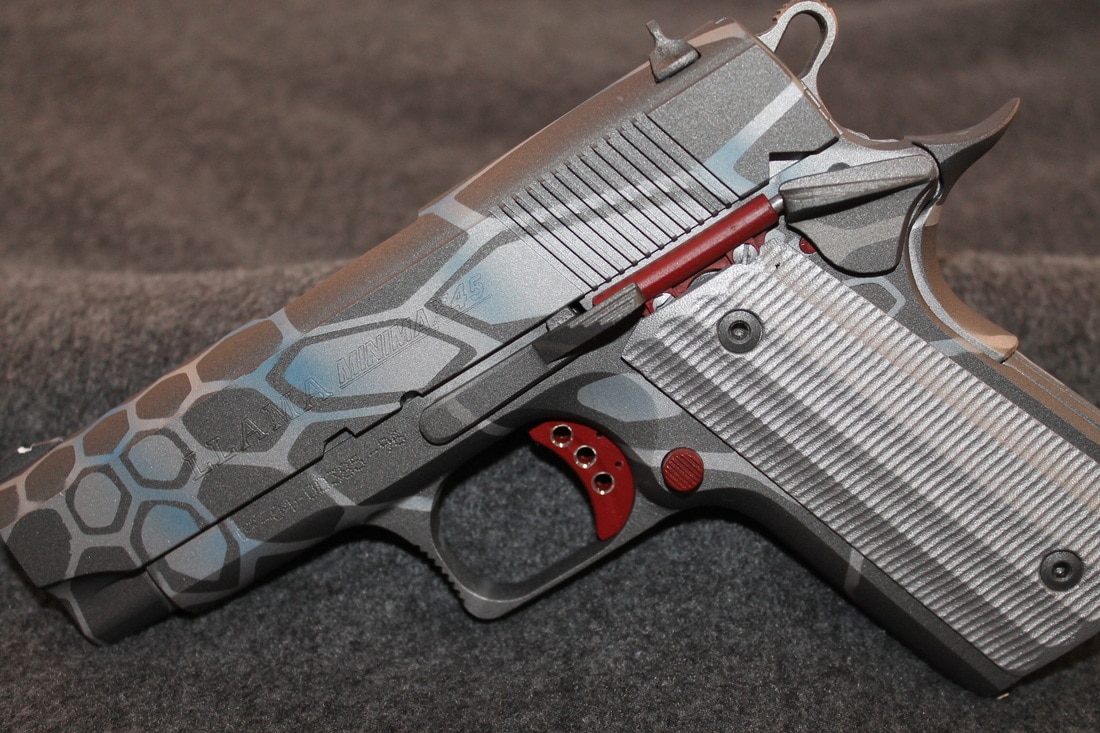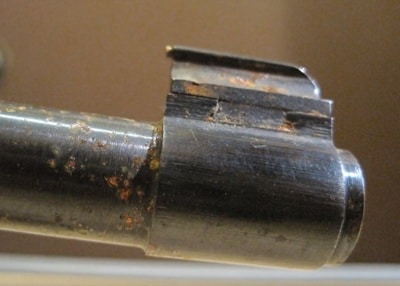If you have looked up information about guns and their durability, then you might have heard of a product called cerakote.
It is a coating that goes on the gun to help protect the metal and moving parts. On top of this it also comes in a variety of colors, so you can have a more custom feel for your firearm that gives it a look that is personal to you. Read on to learn more in-depth information on what Cerakote is and its benefits.

Cerakote Pistol. source: killercoating
What is Cerakote?
For many years their was only a few ways to protect your gun from the elements. Guns have always been made of metal and some times the steel was blued. This was a heating process to help protect it from pitting and corrosion. Since guns are used outside a lot, they are easily exposed to the weather. Things such as water could easily cause the metal to rust which could lead to the gun not functioning correctly.
On older guns parts of them, such as the handle or butt, were also made of wood. Wood also would break down over time and wear. As time when on people started using pearl grips and things to help protect the parts of the gun that were exposed to wear and the weather more often. Today there is a new product that can protect your gun.
This new product to help your gun last as long as possible is Cerakote. It is a ceramic type material with a polymer mixed into it to help it attach to all kinds of material. Now that guns have a lot more moving parts, it is even more important to keep your gun protected from the elements.
How is Cerakote Applied?
Cerakote is applied in a very skilled way because a small amount of thickness change in a gun can cause it to not function right. The first thing is the gun is completely disassembled, not just field-stripped. It is then degreased and blasted with garnet sand to remove any oils. After the coating is put on in a smooth and even way using an HVLP spray gun. Lastly the metal parts are cured at 250 degrees and the plastic and polymer parts are cured at 150-180 degrees.
Benefits of Cerakote?
So now that you know what Cerakote is and how it is applied, what are the benefits to it? Well like has been mentioned guns have a lot of moving parts now a days, and any wear on these parts can cause the gun to stop functioning correctly. A lot of things can cause wear to a gun from normal use to mishandling.
Normal wear occurs because you have oils on your hands that can eat into the metal parts over time. Also, the slide part of the gun is moving back and forth which causes friction. If your gun does not have a slide but is instead a hammer, the hammer hitting still causes wear. The bullet also coming out of the chamber causes wear over time to the inside of the barrel. Also, the small explosion on the inside each time to propel the bullet out causes wear.
Some of these wear causing things can be slowed down with proper care. If you clean your gun and oil it regularly, then it reduces the effects of the friction. Also, some of the smaller parts can be replaced easily and this will help your gun last longer, but some mishandling things or accidents can't be prevented or protected against in other ways.
Carrying the gun can lead to it getting scratches and things just from it bumping into things. These cosmetic issues don't really affect the function, but if you are spending a lot on a gun you probably want it to stay looking good for as long as possible as well. Also, a drop could cause cosmetic damage and functioning damage, but if you have a coating on the gun these damages can be reduced.
Cerakote puts a layer on the outside of the gun that is hard and protective. The ceramic in the Cerakote keeps the gun from getting scratched if it bumps into different things or gets dropped. The thin layer also protects the moving parts from wear. This keeps the gun in the proper specifications for longer so you don't have to replace parts and it keeps functioning correctly. Lastly it protects the gun from the elements, such as water, so the metal does not rust or pit.
The other benefits are that Cerakota comes in over a hundred colors. This means you can get your gun to look however you want. You can even have different parts of the gun be different colors, so the possibilities are endless. Some might think that customizing the color is just for aesthetics, but doesn't add any real benefits. While this is mostly true, it isn't completely true. If you are wanting to hide your gun, then you can get it in a color that is more easily concealed. That is one reason why getting a custom color can add more benefits than just making you happy.
Should you get Cerakote?
So you still may be wondering should you do it to your firearm.
My answer would be yes.
It is an added cost, but it will keep your gun functioning correctly for a lot longer. The added protection for your gun and then the fact you can make your gun your own, out weights any cost. The technique used now makes it so getting Cerakote on your gun will not do any harm to it.
You should have the best handgun safe to protect your Cerakote pistol.
Conclusion
Cerakote adds a lot of benefits to your gun at no risk besides the cost of having it down. While there are a few other options on the market, Cerakote is the tested method that a lot of people love. If you are looking for a way to protect your firearm, or to make the gun your own, then Cerakote is a great option for you.

